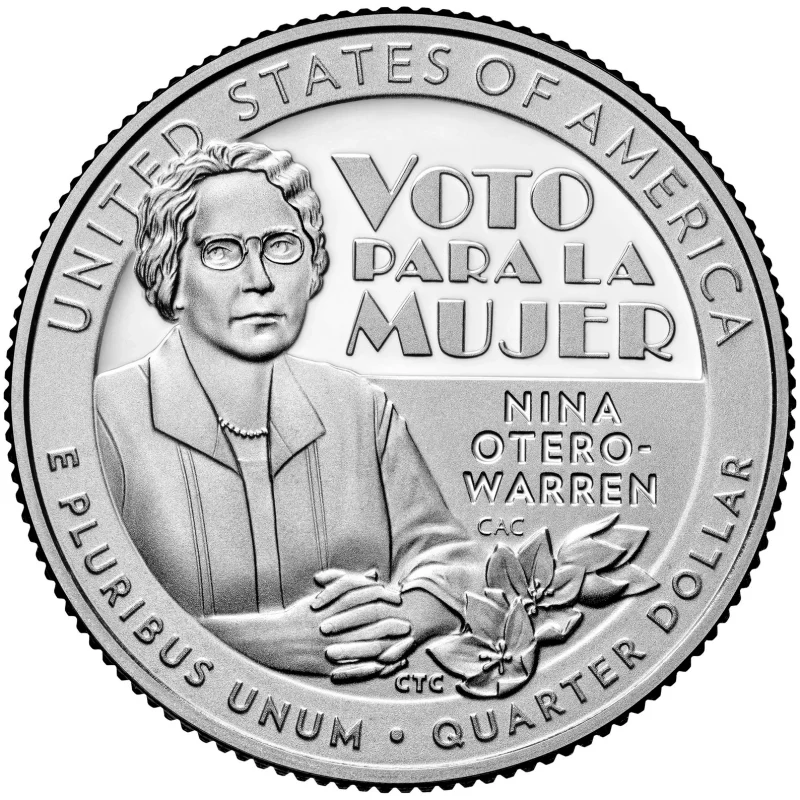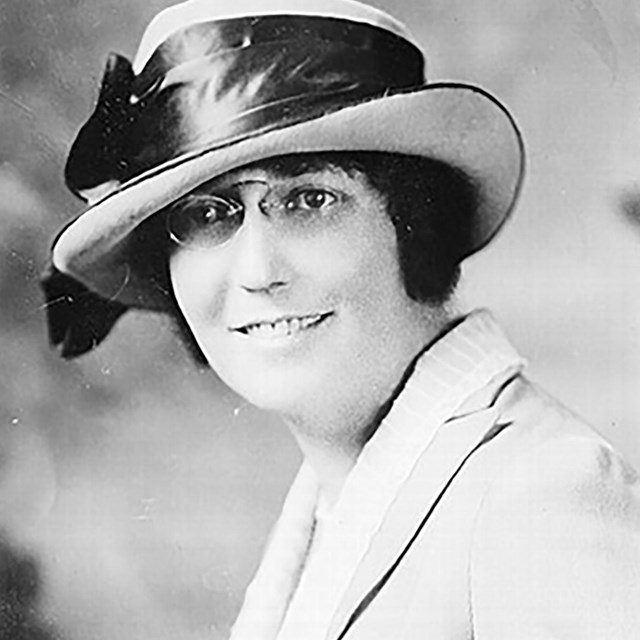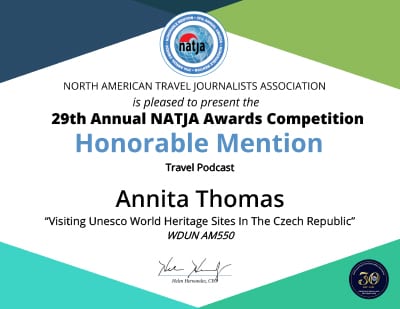
Photo- U.S. Mint
Nina Otero-Warren
American Women Quarters Program
Nina Otero Warren – Women Nina was a leader in New Mexico’s suffrage movement, the first woman to be superintendent of Santa Fe public schools, Chairman of New Mexico’s Board of Health, an executive board member of the American Red Cross and director of an adult literacy program in New Mexico for the Works Projects Administration.
Nina has a long list of leadership accomplishments as an activists for Hispanic people.
And, today she is the fifth woman featured on a quarter in the American women quarter program
On this podcast I tell her story.
Born María Adelina Isabel Emilia Otero on October 23, 1881 on her family’s hacienda, “La Constancia,” near Los Lunas, New Mexico.
She was born into a prominent political family where Her parents, Manuel B. Otero and Eloisa Luna could trace their lineages to the early Spanish colonizers in the area.
At an early age she experienced the loss of her father who was killed by a squatter trying to settle on her family’s land.
The loss of her father had a great impact on her and the family. Her mother remarried in 1886. And, Nina stepped in to help take care of her younger siblings
She attended St. Vincent’s Academy in Albuquerque and Maryville College of the Sacred Heart (now Maryville University) in St. Louis.
However home was never far away…… always on her mind and in her heart. She returned to the family’s hacienda to help care for her younger siblings. She helped educate her siblings and contributed to the work on the family ranch — later when she wrote her book …. These were the experiences she recorded in her book, Old Spain in Our Southwest.
She became interested in activism In 1897, when her family moved to Santa Fe. It was there where her cousin, Miguel Otero II, became the governor of the New Mexico Territory and appointed her stepfather as a judicial clerk.
Now as an adult she was called Nina. Living in Santa Fe, she was around many people who inspired her as she socialized among the political and cultural elite of Santa Fe.
Nina met Rawson D. Warren, an officer in the Fifth U.S. Cavalry stationed at Fort Wingate. She married Warren on June 25, 1908 becoming….Nina Otero-Warren, the name she carries for the life and how we know her. She was 26 years old.
After their Santa Fe wedding, Nina and Rawson moved to Fort Wingate. Unhappy in her marriage, Nina divorced her husband after only two years, and returned to Santa Fe.
During that time, there were many attitudes prejudices against divorced women at the time, She decided to identify as a widow and continued to use her hyphenated name.
In 1912 Nina moved to New York City to help and support her brother who was studying at Columbia University. While there, she worked in the settlement house movement. Another opportunity to strengthen her fight for her people.
When her mother passed in 1914, and she decided to move back to Santa Fe
During her life Otero-Warren was very accomplished in many areas:
Always emphasized the use of the Spanish language in the suffrage fight in order to reach Hispanic women.
She also spearheaded the lobbying effort to ratify the 19th Amendment in New Mexico.
Otero-Warren believed in education and worked to improve education for all New Mexicans
Advancing and preserving bicultural education and cultural practices among the state’s Hispanic and Native American communities was very important to her.
In 1917, Otero-Warren was appointed superintendent of public schools in Santa Fe. She defeated a male opponent to win reelection to the position in 1918 and remained in the role until 1929.
Her focus as superintendent was to promote adult education programs, setting up a county high school, raising teacher standards and their salaries, and improving the physical conditions of schools.
It was undeniable that she held a strong sense of pride in her Spanish cultural heritage and made major efforts to oppose the federal government’s trend toward assimilating non-Anglos into white America.
During this time, the federal government was pressuring for assimilation of non-whites, including Native American and Hispano people, into white America. This assimilation meant loss of traditional language, customs, and often family ties. As Superintendent of Public Schools, Nina worked to balance the demands of the federal government.
Nina Otero Warren rgued that both Spanish and English be allowed in schools, despite the federal mandate of English-only. For a few years beginning in 1923, she was also appointed Santa Fe County’s Inspector of Indian Schools.
Not only public schools, She also served as Santa Fe’s County Inspector of Indian Schools. Without surprise, she was critical of the federal government and the poor condition of the schools. Her greatest argument was that the boarding schools threatened Indian family life and cultural stability.
Along with Alice Paul, who had supported Nina in 1917 to head the New Mexico chapter of the Congressional Union (precursor to the National Woman’s Party). Nina and other activists realized that the support of Hispanic culture and language in New Mexico was crucial to winning suffrage.
She also served as chair of the New Mexico Republican State Committee’s women’s division and as chair of the Legislative Committee of the New Mexico Federation of Women’s Clubs. And served as the Chairman of New Mexico’s Board of Health; an executive board member of the American Red Cross; and director of an adult literacy program in New Mexico for the Works Projects Administration.
Nina Otero Warren used her political connections and leverage to campaign for woman’s suffrage and to forcefully lobby the state legislature to ratify the 19th Amendment, which it did on February 21, 1920.
She did run for federal office, for the U.S. House of Respresentatives….However, she lost the general election by fewer than 10,000 votes.
It is said in part due to the public’s discovery that she was divorced rather than widowed. And, being divorce was not looked upon as acceptable at that time. And, she never rang for public office again.
However, that didn’t stop her from her work as an ativists.
Nina Otero-Warren American Women Quarter Program is featured on the quarters because of her activism. She served as New Mexico’s director of literacy education for the Civilian Conservation Corps in the 1930s and director of the Works Progress Administration in Rio Piedras, Puerto Rico in the 1940s.
During World War II, she ran the Santa Fe County Office of Price Administration, charged with enforcing the federal government’s price controls.
With such a powerful way of leading and accomplishing civil rights for Hispanic people, you might wonder what was the woman like…. What was her personality.
Nina became a regular fixture in the social life of the Santa Fe elite,
She was described as “a graceful, intelligent young woman with an indomitable disposition,” and “high spirited and independent.”
Throughout her life, Nina was known both for her proper, mannered expectations of others and her unconventional personal life.
Although she never remarried or had children of her own, she took her role as “La Nina” or godmother to her siblings, nieces and nephews, and arguably to her community very serious. Each relationship was very important to her.
In the early 1930s, Nina Otero Warren and her partner Mamie Meadors established a ranch called “Las Dos” (The Two Women)
Outside of Santa Fe. They paid $67.40 for two homestead applications, and agreed to spend an average of five months a year living on their homestead, and to improve the land by building two houses, fencing the property which was around 1,257 acres), cultivating the land, and maintaining the road for five years.
By adhering to and meeting the homesteading requirements, of the Homesteading Act of 1862, they received title to the land.
In 1947, Nina Otero Warren and Mamie established a real estate and insurance company, also called “Las Dos” in Santa Fe. She and Meadors established Las Dos Realty and Insurance Company in 1947
Mamie died in 1951, but Nina continued running the business. Neither woman ever publicly announced the details of their relationship. What was known by everyone that they loved what they were doing and working together for over twenty years to achieve.
To capture her full life on paper and share it with the world, Nina starting writing and published “My People” for an issue of Survey Graphic. The them was Mexicans in our Midst: newest and Oldest Settlers of the Southwest” In May 1931.
In the early 1960’s Nina moved back to the family property in Santa Fe after the death of her brother. It was there where Nina died on January 3, 1965.
Otero-Warren, known in the state as a dedicated and skilled public servant, who fought for culture, tradition, laugnuage, education, health and welfare during her lifetime. She is an outstanding American woman.
The Nina Otero-Warren Quarter is the fourth coin in the American Women Quarters™ Program. And, this is her story.
For more information and to visit places where you can learn more about Nina Otero Warren, visit the website below:
National Park Service – nps.gov
National Women’s History Museum – Washington DC – womenshistory.org
Albuquerque library – ABQlibrary.org
Photos


Ready to hear about another outstanding American Woman? Here are story of Wilma Mankiller




0 Comments